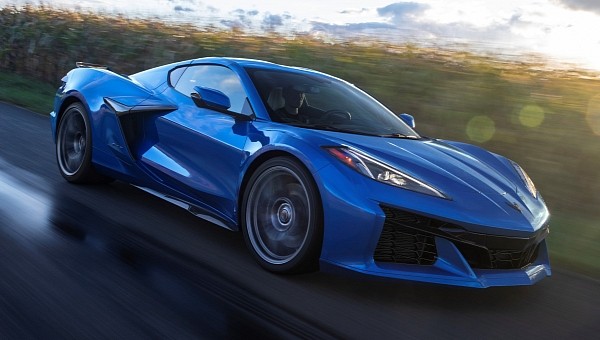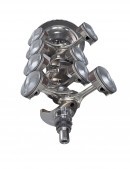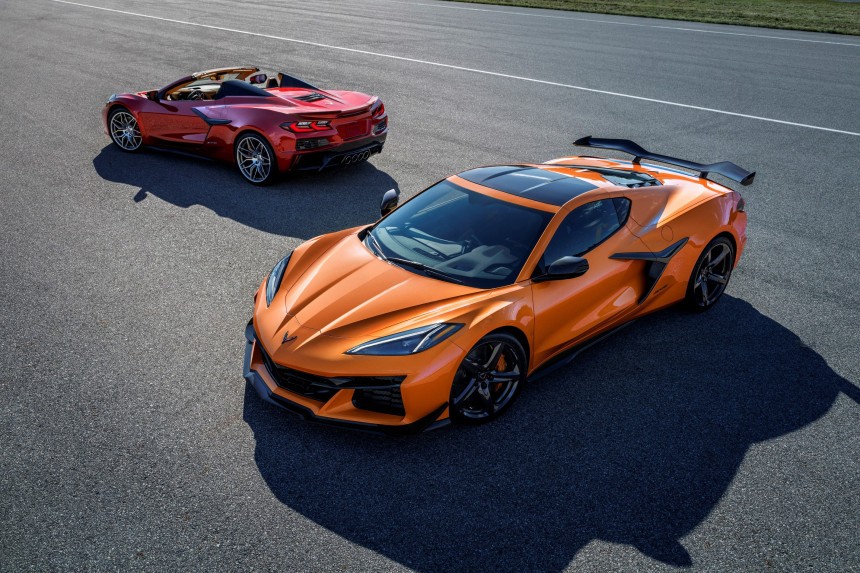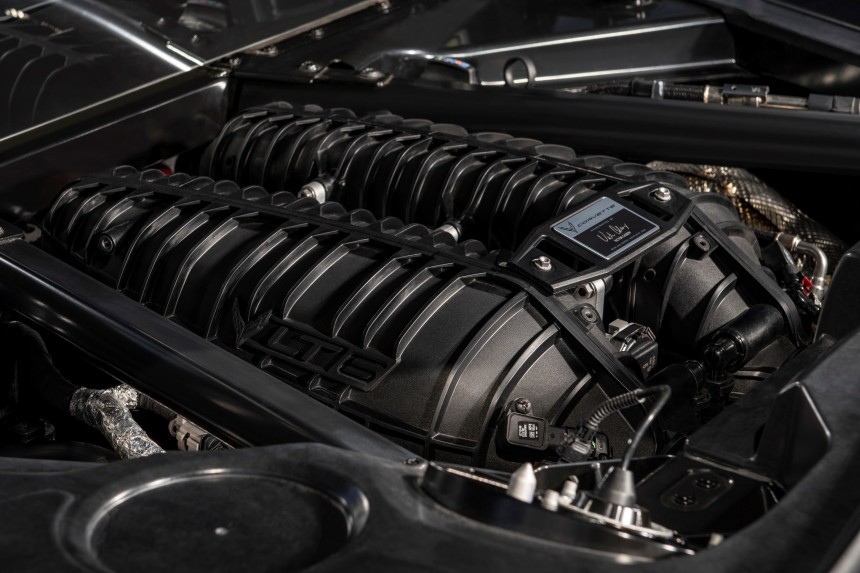The Corvette saw many watershed moments throughout its 69-going-on-70-year existence, the first being in 1955 with the introduction of the small-block V8. The gentleman responsible for this improvement of the breed was none other than Zora Arkus-Duntov, born Zachary Arkus.
He joined General Motors in 1953, the year General Motors displayed the Motorama Corvette in New York City. Despite finding the sports car beautiful, Duntov was disappointed with the C1’s humble underpinnings. Also credited with developing the Duntov high-lift camshaft, the Belgian-born American engineer further perfected the Chevrolet division’s halo car with Rochester Ramjet mechanical fuel injection for model year 1957.
Come 1959, he finished the Chevrolet Engineering Research Vehicle. Better known as CERV I, this mid-engine design study with small-block V8 muscle never left Duntov’s mind. His engineering team subsequently rolled out the Wankel-engined Aerovette in 1969, a series of two midship prototypes that could have previewed the midship ‘Vette had it not been for the 1973 oil crisis. When Duntov heard from the bean counters and suits in Detroit that a mid-engine sports car isn’t feasible, he resigned in frustration. Dave McLellan took over chief engineer duties for the Corvette in '75.
Zora failed to realize his midship dream, but as fate would have it, his idea came to fruition for the 2020 model year with the introduction of the C8. Still powered by a small block, although a very clever one of those as opposed to the original 265-ci lump, the eighth generation was developed as a midship for a very good reason. When the engineering team realized that the seventh-generation ZR1 would reach the maximum potential of the Y platform, they didn’t really have a choice but go midship for the C8.
A better-handling ‘Vette than its front-engined forerunner, the C8 Stingray marks – without a shadow of a doubt – a watershed moment as well. The introduction of the Z06, however, elevated the Corvette from America’s sports car to the “American supercar that puts the world on notice.”
That passage comes straight from the October 26th, 2021 press release for the all-new Z06 from General Motors, and it perfectly encapsulates why the 2023 Corvette Z06 is autoevolution’s most improved car for 2022.
The Big G rarely put so much effort into a variant of the Corvette, changing so many things over the Stingray. The fourth-generation ZR1 also comes to mind, the first series-production Corvette to feature a DOHC valvetrain. The ZR1 from that era, however, isn’t 100 percent General Motors by design. The ZR1-specific LT5 shares the 4.4-inch bore spacing of the L98 small block, yet Lotus engineered the damn thing in the UK. Not considered a true small block, the LT5 does not feature reverse flow cooling either.
Guess what? Erroneously considered a small block, the LT6 in the Z06 also features 4.4-inch bore spacing. Unrelated to the Cadillac CT6-V Blackwing V8 engine, a.k.a. regular production order code LTA, the naturally-aspirated lump isn’t related to LS-based motors either. It’s a clean-sheet design, and the LT6 isn’t shared with any other series-production vehicle from the GM portfolio. As mentioned in the previous paragraph, the Detroit-based company rarely puts this kind of effort into a variant of the Corvette.
The biggest departure from the C4 ZR1’s LT5 is the adoption of a flat-plane crankshaft, a design that even Maserati was barred from using despite a long tradition of using Ferrari-developed powerplants. The F154 comes with a flat-plane crankshaft in Prancing Horses, while the House of the Trident has to make do with a cross-plane crankshaft. The Maserati MC20’s Nettuno V6, as well as the Alfa Romeo Quadrifoglio-spec V6 engine, are closely related to the F154 as well. Both twin-turbo sixers boast cross-plane crankshafts.
Derived from the naturally-aspirated sixer of the C8.R endurance racer, the LT6 is the largest flat-plane crankshaft V8 in the world. It’s also the most powerful naturally-aspirated V8 ever fitted to a series-production vehicle thanks to 670 horsepower at a screaming 8,400 rpm, dethroning the 622-horsepower M159 engine of the Mercedes-Benz SLS AMG Black Series.
Partially developed to spite the Ford Motor Company for its now-discontinued Voodoo engine, the 5.5-liter LT6 is rocking dual throttle bodies, the defining technical novelty of the fourth-gen Coyote in the 2024 Mustang. Each cylinder breathes in through dedicated intake trumpets, and the LT6 has another clever trick to show for itself, that being dynamic supercharging.
Taking advantage of the Helmholtz resonance credited to physicist Hermann von Helmholtz, the aim of dynamic supercharging is rather simple. To make a long story short, the clever minds behind the LT6 achieved a volumetric efficiency of 110 percent. Volumetric efficiency refers to how well the air and exhaust flow through an engine. Said trick explains the nearly flat torque curve up to 6,300 rpm, where torque crescendos to 460 lb-ft (623 Nm).
The Z06 uses an eight-speed transaxle similar in design to the Stingray, although different where it really matters. As opposed to the M1L, the M1M features an additional odd clutch plate, a strengthened hub and basket, a deeper effective final-drive ratio, a strengthened case and bellhousing, and larger output shaft flanges designed to support high-strength half shafts.
As if the aforementioned improvements weren’t impressive enough, the eighth-generation Z06 is the first Corvette to be offered with carbon-fiber wheels. Once again, GM likely took inspiration from the Voodoo-engined Shelby GT350R, the first series-production car by a major automaker to sport carbon-fiber wheels. There are many other things that make the Z06 the hottest car of the moment, one of those things being the sticker price.
Not accounting for markups, $105,300 before taxes and extras may seem a little steep compared to the $78,000 seventh-generation Z06, but remember that we’re dealing with a wholly different level of on-road and on-track performance with this bad boy. You further have to adjust the MSRP of the C7 Z06 for inflation, which means $98,075 in today’s money. What kind of alternatives do you have at this price point? The Porsche 911 Carrera currently retails at $106,100 before taxes, but it’s not as well equipped nor as rewarding to drive as the greatest Z06 yet. Wait, scratch that!
It's the greatest Corvette yet by far, and it’s only going to get more exotic from here onwards with the twin-turbocharged LT7 engine in the ZR1. Later on, the Zora – named after the one and only Zora-Arkus Duntov – will likely combine the LT7 of the ZR1 with the electrified front axle of the E-Ray.
Come 1959, he finished the Chevrolet Engineering Research Vehicle. Better known as CERV I, this mid-engine design study with small-block V8 muscle never left Duntov’s mind. His engineering team subsequently rolled out the Wankel-engined Aerovette in 1969, a series of two midship prototypes that could have previewed the midship ‘Vette had it not been for the 1973 oil crisis. When Duntov heard from the bean counters and suits in Detroit that a mid-engine sports car isn’t feasible, he resigned in frustration. Dave McLellan took over chief engineer duties for the Corvette in '75.
Zora failed to realize his midship dream, but as fate would have it, his idea came to fruition for the 2020 model year with the introduction of the C8. Still powered by a small block, although a very clever one of those as opposed to the original 265-ci lump, the eighth generation was developed as a midship for a very good reason. When the engineering team realized that the seventh-generation ZR1 would reach the maximum potential of the Y platform, they didn’t really have a choice but go midship for the C8.
A better-handling ‘Vette than its front-engined forerunner, the C8 Stingray marks – without a shadow of a doubt – a watershed moment as well. The introduction of the Z06, however, elevated the Corvette from America’s sports car to the “American supercar that puts the world on notice.”
That passage comes straight from the October 26th, 2021 press release for the all-new Z06 from General Motors, and it perfectly encapsulates why the 2023 Corvette Z06 is autoevolution’s most improved car for 2022.
Guess what? Erroneously considered a small block, the LT6 in the Z06 also features 4.4-inch bore spacing. Unrelated to the Cadillac CT6-V Blackwing V8 engine, a.k.a. regular production order code LTA, the naturally-aspirated lump isn’t related to LS-based motors either. It’s a clean-sheet design, and the LT6 isn’t shared with any other series-production vehicle from the GM portfolio. As mentioned in the previous paragraph, the Detroit-based company rarely puts this kind of effort into a variant of the Corvette.
The biggest departure from the C4 ZR1’s LT5 is the adoption of a flat-plane crankshaft, a design that even Maserati was barred from using despite a long tradition of using Ferrari-developed powerplants. The F154 comes with a flat-plane crankshaft in Prancing Horses, while the House of the Trident has to make do with a cross-plane crankshaft. The Maserati MC20’s Nettuno V6, as well as the Alfa Romeo Quadrifoglio-spec V6 engine, are closely related to the F154 as well. Both twin-turbo sixers boast cross-plane crankshafts.
Derived from the naturally-aspirated sixer of the C8.R endurance racer, the LT6 is the largest flat-plane crankshaft V8 in the world. It’s also the most powerful naturally-aspirated V8 ever fitted to a series-production vehicle thanks to 670 horsepower at a screaming 8,400 rpm, dethroning the 622-horsepower M159 engine of the Mercedes-Benz SLS AMG Black Series.
Partially developed to spite the Ford Motor Company for its now-discontinued Voodoo engine, the 5.5-liter LT6 is rocking dual throttle bodies, the defining technical novelty of the fourth-gen Coyote in the 2024 Mustang. Each cylinder breathes in through dedicated intake trumpets, and the LT6 has another clever trick to show for itself, that being dynamic supercharging.
The Z06 uses an eight-speed transaxle similar in design to the Stingray, although different where it really matters. As opposed to the M1L, the M1M features an additional odd clutch plate, a strengthened hub and basket, a deeper effective final-drive ratio, a strengthened case and bellhousing, and larger output shaft flanges designed to support high-strength half shafts.
As if the aforementioned improvements weren’t impressive enough, the eighth-generation Z06 is the first Corvette to be offered with carbon-fiber wheels. Once again, GM likely took inspiration from the Voodoo-engined Shelby GT350R, the first series-production car by a major automaker to sport carbon-fiber wheels. There are many other things that make the Z06 the hottest car of the moment, one of those things being the sticker price.
Not accounting for markups, $105,300 before taxes and extras may seem a little steep compared to the $78,000 seventh-generation Z06, but remember that we’re dealing with a wholly different level of on-road and on-track performance with this bad boy. You further have to adjust the MSRP of the C7 Z06 for inflation, which means $98,075 in today’s money. What kind of alternatives do you have at this price point? The Porsche 911 Carrera currently retails at $106,100 before taxes, but it’s not as well equipped nor as rewarding to drive as the greatest Z06 yet. Wait, scratch that!
It's the greatest Corvette yet by far, and it’s only going to get more exotic from here onwards with the twin-turbocharged LT7 engine in the ZR1. Later on, the Zora – named after the one and only Zora-Arkus Duntov – will likely combine the LT7 of the ZR1 with the electrified front axle of the E-Ray.











































